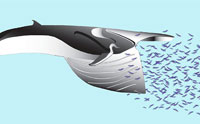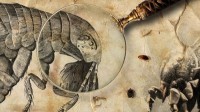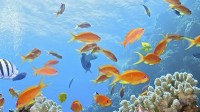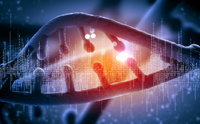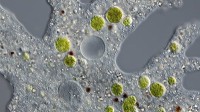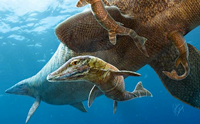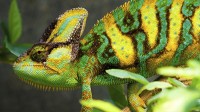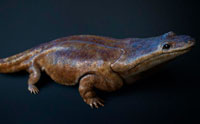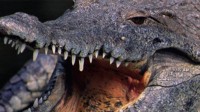A few years ago, scientists discovered a unique sensory organ in the jaw of a rorqual whale—the world’s largest creature. Rorqual whales, which include the blue whale and fin whale, feed by ballooning out folds of tissue that bag gobs of krill from fertile ocean waters. Some of those researchers recently described the unique bungee-cord-like nerve fibers that illustrate clever and intentional design. More… …read more Read more here: icr.org
By Dr. Jean Lightner Researchers say the “big bang” of bird evolution has been mapped, revealing the history and origin of birds, but they assume all life shares a common ancestry. …read more Read more here: AIG Daily
By Frank J. Sherwin, III Fleas are considered a nuisance. How can they be explained as a part of God’s very good creation? …read more Read more here: AIG Daily
The tuatara is a small reptile that defies evolutionary explanations. …read more Read more here: creation.com
By Dr. Elizabeth Mitchell Did millions of years in the dark evolve away cave crustaceans’ eyes and the brain to see? …read more Read more here: AIG Daily
By Yingguang Liu The molecular interaction of HIV-1 is merely cyclic fine-tuning of an existing function and illustrates the broken relationship between the virus and the host. …read more Read more here: AIG Daily
‘Atavistic tails’ and evolution: are some people born with a throwback to a tailed monkey ancestor? …read more Read more here: creation.com
The discovery of a super-complex machine has the world’s best scientific minds scrambling for answers. …read more Read more here: creation.com
Scientists have long been baffled as to what actually tells proteins called transcription factors (TFs) where to bind in the genome to turn genes off and on. However, new research incorporating the three-dimensional shape of DNA has revealed an incredibly complex system of interacting biochemical codes. More… …read more Read more here: icr.org
By Dr. Elizabeth Mitchell Trickle-down chemistry supposedly solves the chemical conundrum concerning the origin of life, but molecules-to-man evolution remains as fictional as ever. …read more Read more here: AIG Daily
Bats are such unique creatures that their existence in the fossil record causes immense problems for evolutionary explanations of their supposed development. …read more Read more here: creation.com
“This is just one more example of protein material being preserved in fossils supposedly many millions of years old with no explanation of how this is possible. The more sensible conclusion is the fossils aren’t millions of years old.” Admin Scientists recently studying a collection of ancient shells were surprised to find not only no evidence of evolution in the specimens, but also clear evidence of protein-rich materials that normally cannot survive millions of years. According to a recent article published in the European Association of Geochemistry’s Geochemical Perspective Letters, researchers analyzed shells found along the coast of Maryland. The [More]
A complex flying machine has scientists struggling to explain how it could have come into existence. …read more Read more here: creation.com
We often hear claims that birds are similar to dinosaurs, but birds and mosasaurs? Mosasaurs were swimming reptiles. How can they be confused with birds? A recent study published in Palaeontology by Yale University’s Daniel Field and his colleagues clears up some of this confusion and in the end, illustrates a mosasaur lifecycle of marvelous design. More… …read more Read more here: icr.org
Why bother with nectar and pollen when there’s meat on the menu? …read more Read more here: creation.com
By Tom Hennigan Chameleons’ skin color can shift dramatically, and in just a few minutes their colors can revert back to the original. How do they do this? …read more Read more here: AIG Daily
Sea urchin spines are made from a crystal that contains impurities that stop cracks propagating. The fine architecture further strengthens the spine. …read more Read more here: creation.com
Scientists in Portugal unearthed a “super salamander” which, although “weird compared to anything today,” is still very much a salamander. The fossilized bones of the six-foot animal were discovered on a hillside dig “chock-full” of bones and declared to originate from the “Upper Triassic” period, some 200 million years ago according to evolutionary dating. But creationists see this as yet another discovery of a created animal that grew to large dimensions in the fertile world before the Flood, and was subsequently buried during the Flood itself. More… …read more Read more here: icr.org
As the genomes of many new creatures rapidly fill the public DNA sequence databases, the problems for the grand evolutionary story are becoming overwhelming. One issue is the fact that different creatures have unique sets of genes specific to their kind with no apparent evolutionary history. To explain this glaring problem, evolutionists have resorted to the myth of pervasive horizontal gene transfer. More… …read more Read more here: icr.org
By Dr. Elizabeth Mitchell Does the “world’s oldest sponge” confirm evolutionary beginnings of multicellular animal life at least 600 million years ago? …read more Read more here: AIG Daily
The humble fingernail turns out to have intricate design. The middle layer has fibres aligned to prevent tearing down to the nail beds, and the two outer layers make nails as strong as hooves. …read more Read more here: creation.com
By Tom Hennigan This paper is meant to lay creation groundwork for lizard systematics with the goal of estimating the number of baramins brought on the Ark. …read more Read more here: AIG Daily
By Dr. Elizabeth Mitchell From almost the same genetic building blocks, DNA, very different results are achieved! But is that the result of evolution, or God’s design? …read more Read more here: AIG Daily
Research indicates that many outward characteristics of organisms may be the result of ‘switching on’ of existing genes in response to the environment. …read more Read more here: creation.com
The bombardier beetle’s explosive secrets are inspiring engineers to design better aircraft engines. …read more Read more here: creation.com
The evolutionary tree of life popularized by Charles Darwin has been shaken to its roots by the molecular genetics revolution. …read more Read more here: creation.com
By Dr. Elizabeth Mitchell To evolutionists, the “butcher” crocodile demonstrates crocodiles had evolved to be major Triassic predators millions of years before dinosaurs ruled the world. …read more Read more here: AIG Daily



















